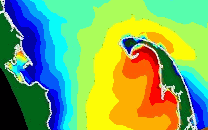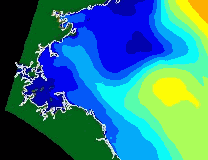

 |
 |
Coastal Ocean Modeling at the USGS Woods Hole Science Center |
|

Click here for a 2.2 Mb FLC
|
Comparison of Effluent Concentration from the Existing and Future Boston Harbor Sewage Outfalls Simulation of effluent dilution from the existing and future Boston
Sewage effluent outfalls based on a three-dimensional circulation model
of Massachusetts Bay during Jan-Mar
1990 and Jun-Aug 1990. Isosurfaces (three-dimensional contours) of effluent
concentration are shown representing 1 part effluent to 200 parts seawater.
This is a level below which nutrient inputs due to the outfall should
be hard to distinguish above background fluctuations. During both the
winter and summer months the effluent from the future outfall (represented
by the blue isosurface) covers a smaller region than the effluent from
the existing outfall (represented by the purple isosurface). These simulations were used as evidence to assess the impact of the future outfall on endangered right whales. |

Click Here for a 0.6 Mb FLC |
Tidal Flushing of Boston HarborSimulation of tidal exchange in Boston Harbor , based on a high-resolution (100 m grid spacing) depth-averaged computer model. Water in Boston Harbor is dyed red, and tracked over three tidal cycles. Colors between red and blue represent mixing of Boston Harbor water with Massachusetts Bay water (dyed blue). Due to the jet-like behavior of the ebb tidal currents, water is expelled from the harbor in pulses, leading to effective flushing of the harbor over several days. |
 Click Here for a 3.0 Mb FLC |
Simulated Particle Trajectories Under a Steady Northeast Wind.Neutrally buoyant floats are tracked for 15 days in circulation driven by a steady 10 m/s Northeast wind. The color of the float is an additional visual cue for depth: when the floats are near the surface, they are red; when they are at 100 m, they are blue. The particles move back and forth with the 12.4 hour period M2 tide, in addition to moving with the wind-driven currents. |
 Click Here for a 4.1 Mb FLC |
Upwelling in Massachusetts Bay during June-July 1990Near-surface temperature (2 m depth) is tracked for 30 days during the summer of 1990, revealing episodic upwelling response to southwest winds. These winds bring cold, nutrient rich water up to the surface in a broad band from Cape Cod Bay to Cape Ann. |
 Click Here for a 3.5 Mb FLC |
Spring Freshet in Massachusetts Bay during April-May 1992Near-surface salinity (2 m depth) is tracked during May 1992, revealing a plume of fresh water from the Merrimack River that moves into Massachusetts Bay. The yellow arrow that flops around indicates the wind direction and speed. Note that a snapshot of the salinity on May 22 (as one might sample from a monthly CTD cruise) would give the distinct visual impression of a large plume from Boston Harbor, when in fact most of this water came from the Merrimack River! |
 Click Here for a 0.8 Mb FLC |
Relative Sea Level Change in Massachusetts Bay: 14,000 years to presentA sea-level curve for the northeastern Massachusetts coastal region was used to make this simulation of sea level change over the last 14,000 years. Isostatic rebound effects are included, but are shown relative to land (instead of land rising while sea-level remains nearly constant, we show sea-level falling while land remains constant). Note that this simulation assumes that the land and seafloor topography in the past was the same as the present, obviously not strictly true for sandy features such as Cape Cod! |
Stellwagen Bank(1.4 Mb) - Download an MPEG Player
Buzzards Bay/Vineyard Sound(1.5 Mb)
Boston Harbor(1.3 Mb)
Gulf of Maine(0.8 Mb)
Long Island Sound(1.6 Mb)
Privacy Statement
Disclaimer
Accessibility
FOIA
 US Department of Interior >
US Geological Survey >
Coastal and Marine Geology >
Woods Hole Science Center
US Department of Interior >
US Geological Survey >
Coastal and Marine Geology >
Woods Hole Science Center

URL: http://woodshole.er.usgs.gov/operations/modeling/index.html
Maintained by: webmaster-woodshole@usgs.gov
Last Modified:
Wednesday, 25-Aug-2004 10:05:19 Eastern Daylight Time